Abstract
Investigations of respiratory symptoms among workers in a factory producing polyurethane foam included measurement of air pollution with amines and isocyanates and a simultaneous health investigation of the exposed workers. An increased bronchial reactivity to inhaled methacholine was found in the study group compared with two unexposed control groups. This finding, together with visual disturbances in the exposed group, were assumed to be caused mainly by the volatile amines. The concentrations of isocyanates in air were well below 0.005 ppm. The amine concentration was 1000 to 10 000 times higher than the isocyanate concentration. The most volatile amine, N-methylmorpholine, occurred in the air in concentrations higher than 10 ppm. The results indicate that not only the isocyanates but also the amines might well be responsible for respiratory symptoms among exposed workers in polyurethane foam production.
Full text
PDF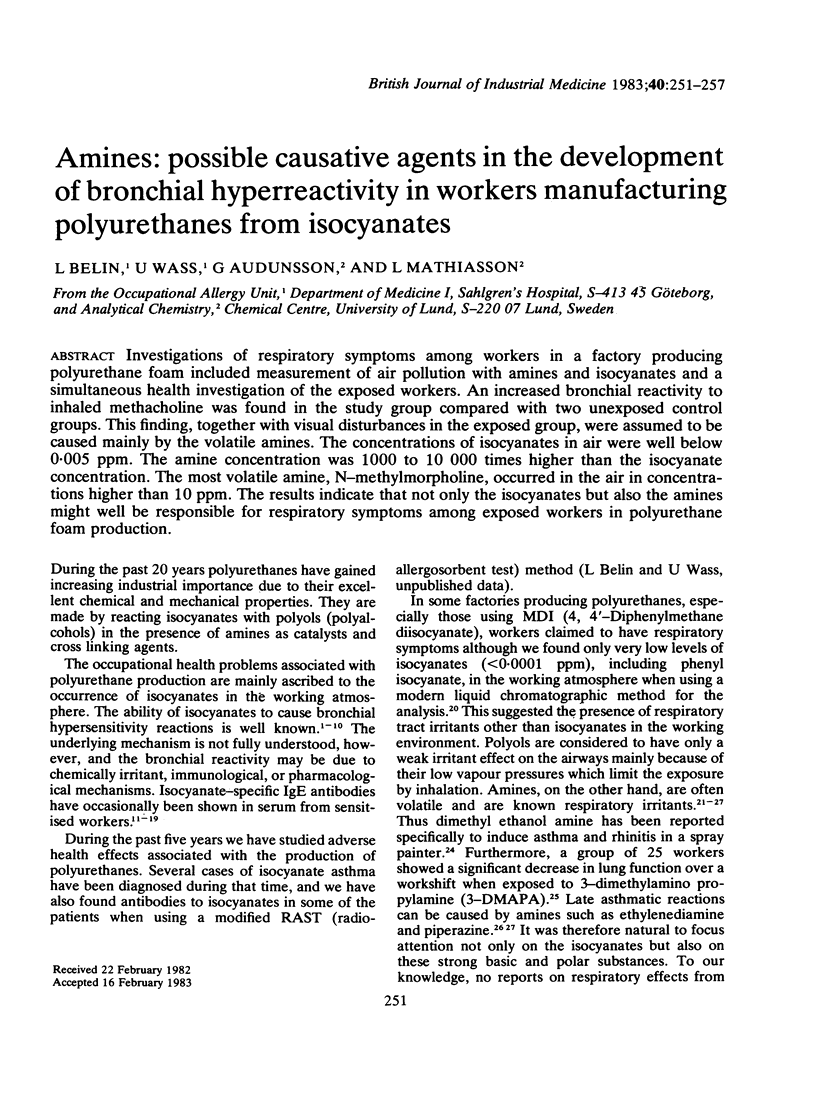

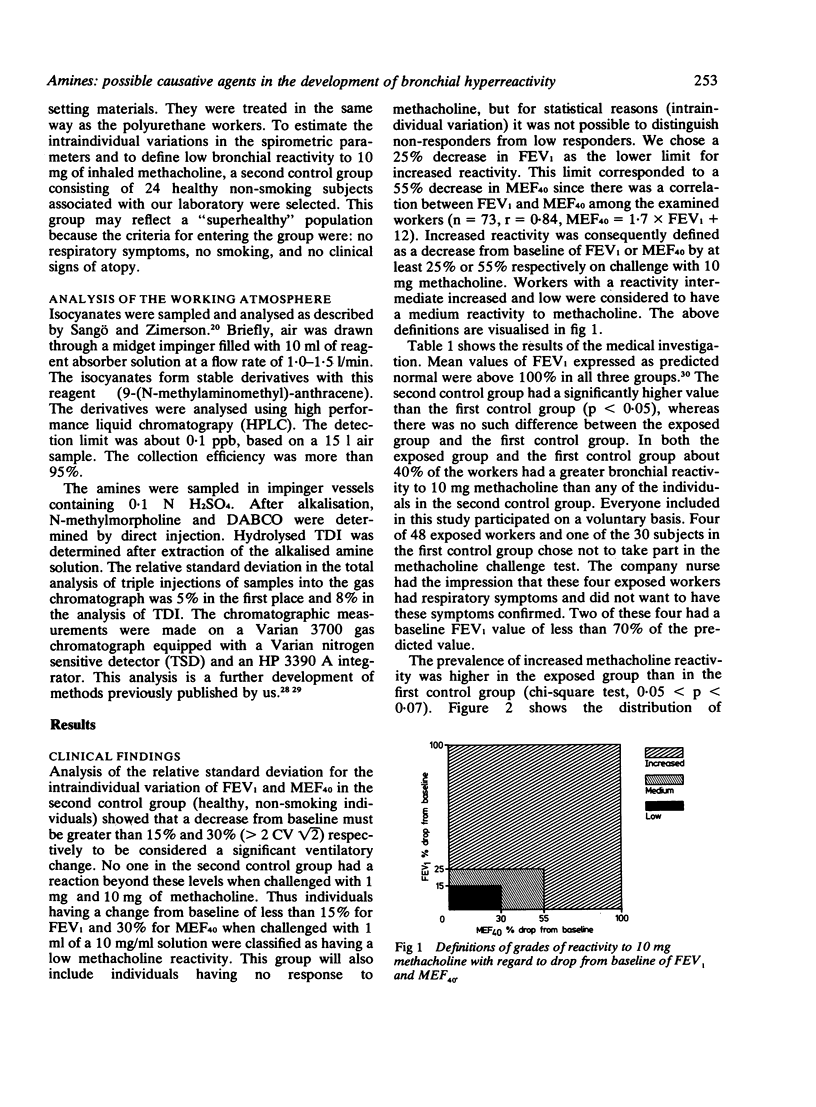
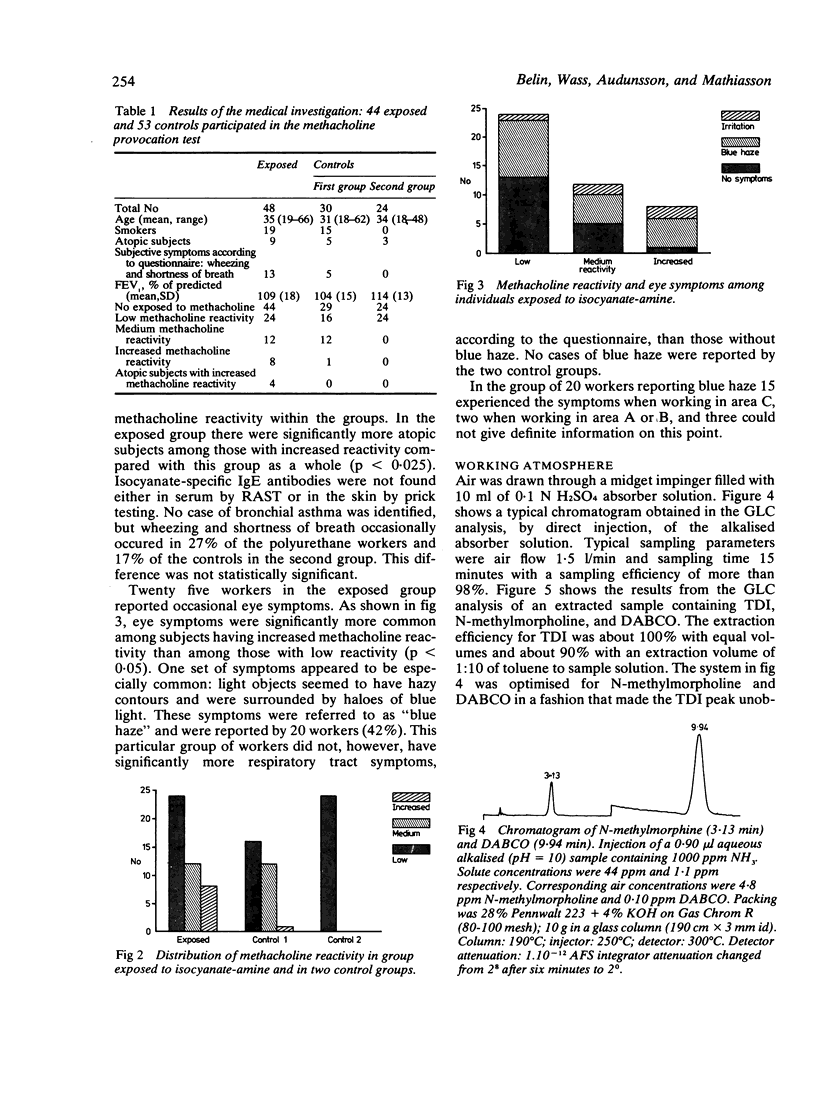
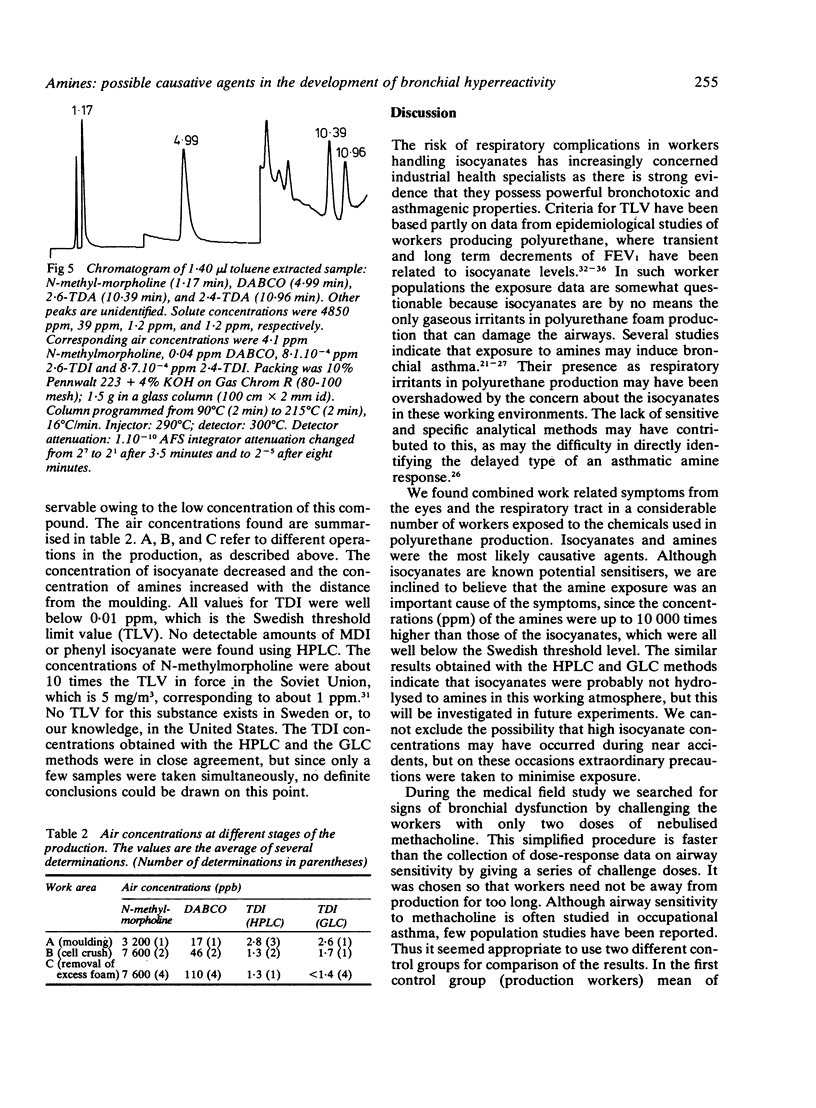
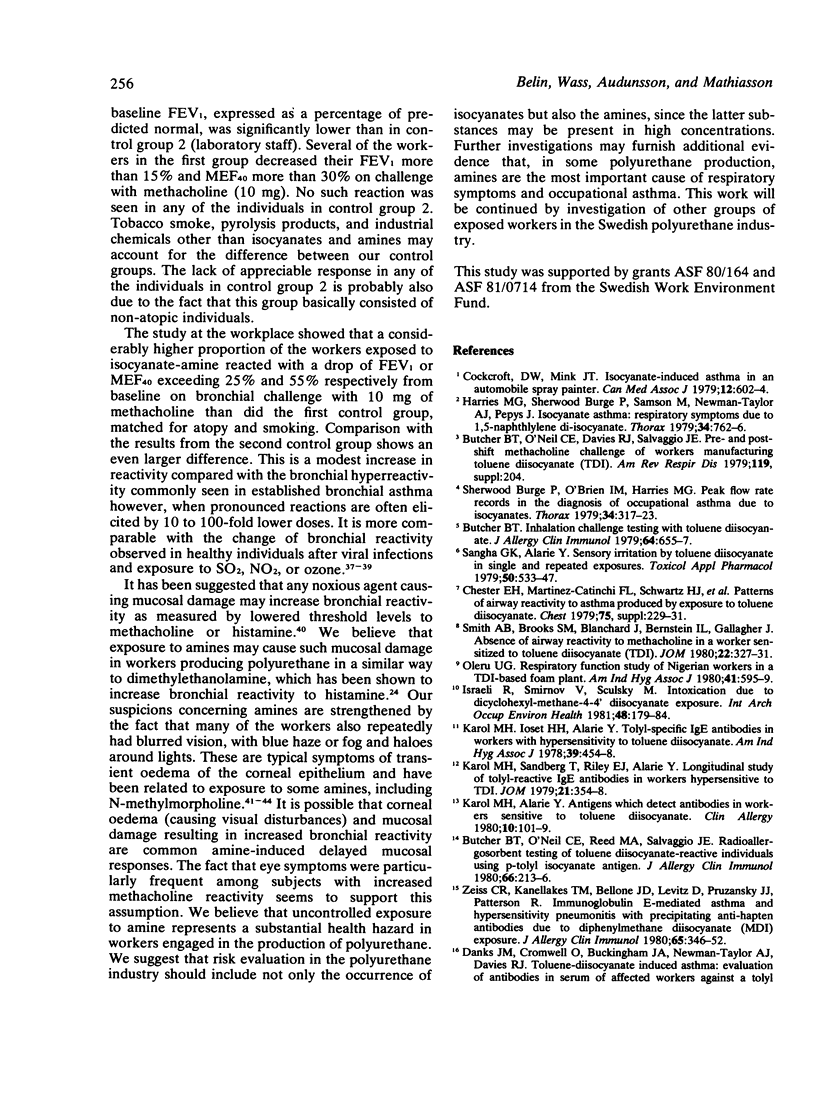
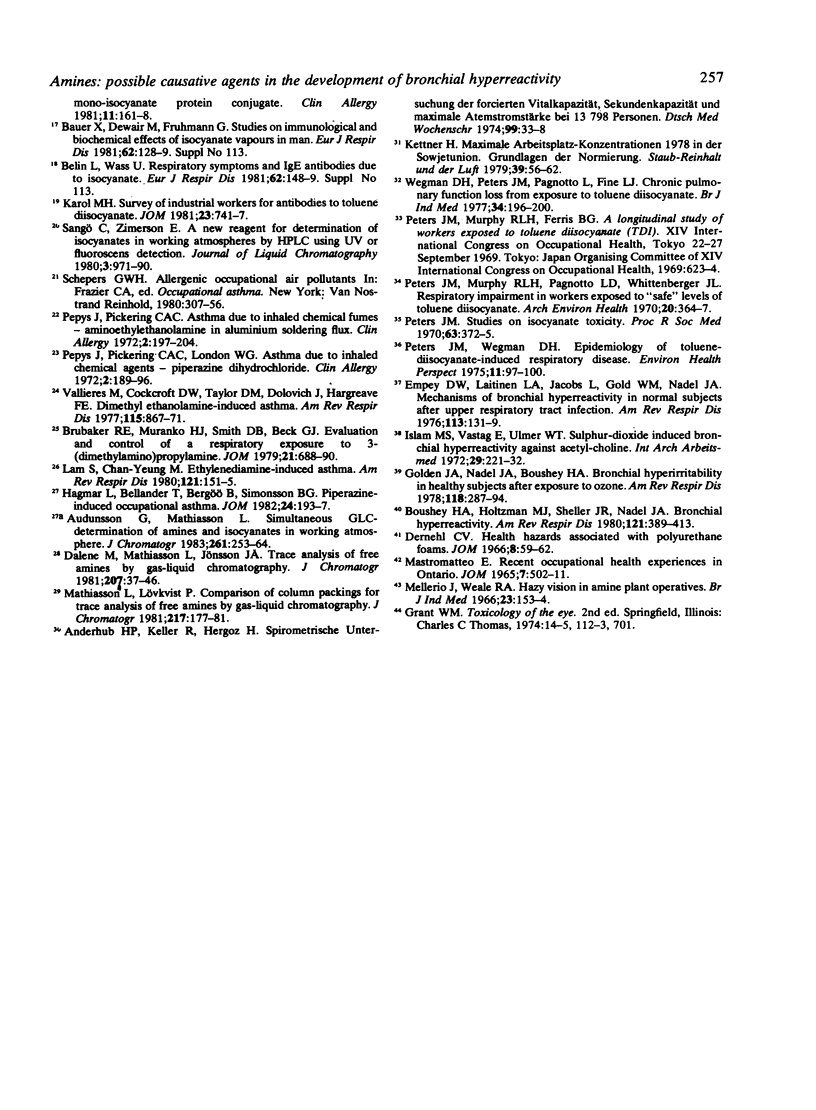
Selected References
These references are in PubMed. This may not be the complete list of references from this article.
- Audunsson G., Mathiasson L. Simultaneous determination of amines and isocyanates in working atmospheres by gas-liquid chromatography. J Chromatogr. 1983 May 27;261(2):253–264. doi: 10.1016/s0021-9673(01)87949-8. [DOI] [PubMed] [Google Scholar]
- Boushey H. A., Holtzman M. J., Sheller J. R., Nadel J. A. Bronchial hyperreactivity. Am Rev Respir Dis. 1980 Feb;121(2):389–413. doi: 10.1164/arrd.1980.121.2.389. [DOI] [PubMed] [Google Scholar]
- Brubaker R. E., Muranko H. J., Smith D. B., Beck G. J., Scovel G. Evaluation and control of a respiratory exposure to 3-(dimethylamino) propylamine. J Occup Med. 1979 Oct;21(10):688–690. [PubMed] [Google Scholar]
- Burge P. S., O'Brien I. M., Harries M. G. Peak flow rate records in the diagnosis of occupational asthma due to isocyanates. Thorax. 1979 Jun;34(3):317–323. doi: 10.1136/thx.34.3.317. [DOI] [PMC free article] [PubMed] [Google Scholar]
- Butcher B. T. Inhalation challenge testing with toluene diisocyanate. J Allergy Clin Immunol. 1979 Dec;64(6 Pt 2):655–657. doi: 10.1016/0091-6749(79)90031-9. [DOI] [PubMed] [Google Scholar]
- Butcher B. T., O'Neil C. E., Reed M. A., Salvaggio J. E. Radioallergosorbent testing of toluene diisocyanate-reactive individuals using p-tolyl isocyanate antigen. J Allergy Clin Immunol. 1980 Sep;66(3):213–216. doi: 10.1016/0091-6749(80)90041-x. [DOI] [PubMed] [Google Scholar]
- Chester E. H., Martinez-Catinchi F. L., Schwartz H. J., Horowitz J., Fleming G. M., Gerblich A. A., McDonald E. W., Brethauer R. Patterns of airway reactivity to asthma produced by exposure to toluene di-isocyanate. Chest. 1979 Feb;75(2 Suppl):229–231. doi: 10.1378/chest.75.2_supplement.229. [DOI] [PubMed] [Google Scholar]
- Cockcroft D. W., Mink J. T. Isocyanate-induced asthma in an automobile spray painter. Can Med Assoc J. 1979 Sep 8;121(5):602–604. [PMC free article] [PubMed] [Google Scholar]
- Danks J. M., Cromwell O., Buckingham J. A., Newman-Taylor A. J., Davies R. J. Toluene-diisocyanate induced asthma: evaluation of antibodies in the serum of affected workers against a tolyl mono-isocyanate protein conjugate. Clin Allergy. 1981 Mar;11(2):161–168. doi: 10.1111/j.1365-2222.1981.tb01580.x. [DOI] [PubMed] [Google Scholar]
- Dernehl C. U. Health hazards associated with polyurethane foams. J Occup Med. 1966 Feb;8(2):59–62. [PubMed] [Google Scholar]
- Empey D. W., Laitinen L. A., Jacobs L., Gold W. M., Nadel J. A. Mechanisms of bronchial hyperreactivity in normal subjects after upper respiratory tract infection. Am Rev Respir Dis. 1976 Feb;113(2):131–139. doi: 10.1164/arrd.1976.113.2.131. [DOI] [PubMed] [Google Scholar]
- Golden J. A., Nadel J. A., Boushey H. A. Bronchial hyperirritability in healthy subjects after exposure to ozone. Am Rev Respir Dis. 1978 Aug;118(2):287–294. doi: 10.1164/arrd.1978.118.2.287. [DOI] [PubMed] [Google Scholar]
- Hagmar L., Bellander T., Bergö B., Simonsson B. G. Piperazine-induced occupational asthma. J Occup Med. 1982 Mar;24(3):193–197. [PubMed] [Google Scholar]
- Harries M. G., Burge P. S., Samson M., Taylor A. J., Pepys J. Isocyanate asthma: respiratory symptoms due to 1,5-naphthylene di-isocyanate. Thorax. 1979 Dec;34(6):762–766. doi: 10.1136/thx.34.6.762. [DOI] [PMC free article] [PubMed] [Google Scholar]
- Islam M. S., Vastag E., Ulmer W. T. Sulphur-dioxide induced bronchial hyperreactivity against acetylcholine. Int Arch Arbeitsmed. 1972;29(3):221–232. doi: 10.1007/BF00539250. [DOI] [PubMed] [Google Scholar]
- Israeli R., Smirnov V., Sculsky M. Vergiftungserscheinungen bei Dicyclohexyl-Methan-4-4'-Diisocyanat-Exposition. Int Arch Occup Environ Health. 1981;48(2):179–184. doi: 10.1007/BF00378439. [DOI] [PubMed] [Google Scholar]
- Karol M. H., Alarie Y. Antigens which detect IgE antibodies in workers sensitive to toluene diisocyanate. Clin Allergy. 1980 Jan;10(1):101–109. doi: 10.1111/j.1365-2222.1980.tb02086.x. [DOI] [PubMed] [Google Scholar]
- Karol M. H., Ioset H. H., Alarie Y. C. Tolyl-specific IgE antibodies in workders with hypersensitivity to toluene diisocyanate. Am Ind Hyg Assoc J. 1978 Jun;39(6):454–458. doi: 10.1080/0002889778507789. [DOI] [PubMed] [Google Scholar]
- Karol M. H., Sandberg T., Riley E. J., Alarie Y. Longitudinal study of tolyl-reactive IgE antibodies in workers hypersensitive to TDI. J Occup Med. 1979 May;21(5):354–358. [PubMed] [Google Scholar]
- Karol M. H. Survey of industrial workers for antibodies to toluene diisocyanate. J Occup Med. 1981 Nov;23(11):741–747. doi: 10.1097/00043764-198111000-00007. [DOI] [PubMed] [Google Scholar]
- Lam S., Chan-Yeung M. Ethylenediamine-induced asthma. Am Rev Respir Dis. 1980 Jan;121(1):151–155. doi: 10.1164/arrd.1980.121.1.151. [DOI] [PubMed] [Google Scholar]
- Mastromatteo E. Recent occupational health experiences in Ontario. J Occup Med. 1965 Oct;7(10):502–511. [PubMed] [Google Scholar]
- Mellerio J., Weale R. A. Hazy vision in amine plant operatives. Br J Ind Med. 1966 Apr;23(2):153–154. doi: 10.1136/oem.23.2.153. [DOI] [PMC free article] [PubMed] [Google Scholar]
- Oleru U. G. Respiratory function study of Nigerian workers in a TDI-based foam plant. Am Ind Hyg Assoc J. 1980 Aug;41(8):595–599. doi: 10.1080/15298668091425347. [DOI] [PubMed] [Google Scholar]
- Pepys J., Pickering C. A. Asthma due to inhaled chemical fumes--amino-ethyl ethanolamine in aluminium soldering flux. Clin Allergy. 1972 Jun;2(2):197–204. doi: 10.1111/j.1365-2222.1972.tb01283.x. [DOI] [PubMed] [Google Scholar]
- Pepys J., Pickering C. A., Loudon H. W. Asthma due to inhaled chemical agents--piperazine dihydrochloride. Clin Allergy. 1972 Jun;2(2):189–196. doi: 10.1111/j.1365-2222.1972.tb01282.x. [DOI] [PubMed] [Google Scholar]
- Peters J. M., Murphy R. L., Pagnotto L. D., Whittenberger J. L. Respiratory impairment in workers exposed to "safe" levels of toluene diisocyanate (TDI). Arch Environ Health. 1970 Mar;20(3):364–367. doi: 10.1080/00039896.1970.10665605. [DOI] [PubMed] [Google Scholar]
- Peters J. M. Studies of isocyanate toxicity. Proc R Soc Med. 1970 Apr;63(4):372–375. doi: 10.1177/003591577006300417. [DOI] [PMC free article] [PubMed] [Google Scholar]
- Peters J. M., Wegman D. H. Epidemiology of toluene diisocyanate (TDI)-induced respiratory disease. Environ Health Perspect. 1975 Jun;11:97–100. doi: 10.1289/ehp.751197. [DOI] [PMC free article] [PubMed] [Google Scholar]
- Sangha G. K., Alarie Y. Sensory irritation by toluene diisocyanate in single and repeated exposures. Toxicol Appl Pharmacol. 1979 Sep 30;50(3):533–547. doi: 10.1016/0041-008x(79)90408-3. [DOI] [PubMed] [Google Scholar]
- Smith A. B., Brooks S. M., Blanchard J., Bernstein I. L., Gallagher J. Absence of airway hyperreactivity to methacholine in a worker sensitized to toluene diisocyanate (TDI). J Occup Med. 1980 May;22(5):327–331. doi: 10.1097/00043764-198005000-00005. [DOI] [PubMed] [Google Scholar]
- Vallieres M., Cockcroft D. W., Taylor D. M., Dolovich J., Hargreave F. E. Dimethyl ethanolamine-induced asthma. Am Rev Respir Dis. 1977 May;115(5):867–871. doi: 10.1164/arrd.1977.115.5.867. [DOI] [PubMed] [Google Scholar]
- Wegman D. H., Peters J. M., Pagnotto L., Fine L. J. Chronic pulmonary function loss from exposure to toluene diisocyanate. Br J Ind Med. 1977 Aug;34(3):196–200. doi: 10.1136/oem.34.3.196. [DOI] [PMC free article] [PubMed] [Google Scholar]


